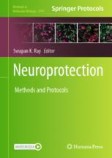Search
Search Results
-
Analysis of electropharmacological and proarrhythmic effects of donepezil using the halothane-anesthetized intact dogs and the conscious chronic atrioventricular block ones
Donepezil, an inhibitor for acetylcholinesterase used for patients with Alzheimer’s disease, has been shown to inhibit I Kr , occasionally inducing...

-
Excitability of the Nociceptive System in Rats after Blast-Induced Traumatic Brain Injury
In a group of healthy adult male albino rats ( n =6), we measured pain thresholds under conditions of electrocutaneous stimulation of the limbs (in a...
-
Blood–Brain Barrier Rescue by Roflumilast After Transient Global Cerebral Ischemia in Rats
Phosphodiesterase 4 inhibitors (PDE4-I), which selectively increase cyclic adenosine monophosphate (cAMP) levels, have shown neuroprotective effects...

-
Electrophysiological Techniques for Studying Tactile Perception in Rats
Neurons communicate by electrical and chemical signals. Neurophysiological studies measuring and manipulating these signals are therefore of utmost...
-
Endothelin-1-mediated Brainstem Glial Activation Produces Asthmatic Airway Vagal Hypertonia Via Enhanced ATP-P2X4 Receptor Signaling in Sprague–Dawley Rats
The occurrence of major asthma symptoms is largely attributed to airway vagal hypertonia, of which the central mechanisms remain unclear. This study...

-
Effects of isoflurane anesthesia on addictive behaviors in rats
RationaleRecently, it has been suggested that isoflurane might reduce dopamine release from rat midbrain dopaminergic neurons, the neurobiological...

-
Behavior of Rats in the Open Field within the Early Period after Light-Degree Blast-Induced Neurotrauma
Blast-induced neurotrauma (BINT) is a specific type of traumatic brain injury (TBI). At present, this type of injury is rather widespread throughout...
-
Early donepezil monotherapy or combination with metoprolol significantly prevents subsequent chronic heart failure in rats with reperfused myocardial infarction
Despite the presence of clinical guidelines recommending that β-blocker treatment be initiated early after reperfused myocardial infarction (RMI),...

-
Cannabidiol Confers Neuroprotection in Rats in a Model of Transient Global Cerebral Ischemia: Impact of Hippocampal Synaptic Neuroplasticity
Evidence for the clinical use of neuroprotective drugs for the treatment of cerebral ischemia (CI) is still greatly limited. Spatial/temporal...

-
Weight-Drop Method for Inducing Closed Head Diffuse Traumatic Brain Injury
Traumatic brain injury (TBI) is one of the foremost causes of disability and death globally. Prerequisites for successful therapy of disabilities...
-
Safety of Intravenous and Inhalation Anesthetics
Here is presented, in chronological order, the studies that established the standards and determined the parameters currently considered for the safe...
-
Screening Methods for the Evaluation of Antihypertensive Drugs
Hypertension is the most common cardiovascular disease, the prevalence of which is increasing with advancing age. The applications of experimental...
-
Metabolism Pharmacology
Safety pharmacology defines studies that investigate the potential undesirable pharmacodynamic effects of a substance on physiological functions in...
-
Screening Methods for the Evaluation of Antiarrhythmic Drugs
Abnormalities associated with impulse generation or conduction can manifest as conduction block or re-entry of cardiac impulse and arrhythmias....
-
Membrane-stabilizing and protective effects of curcumin in a rotenone-induced rat model of Parkinson disease
Parkinson disease (PD) is a chronic progressive neurodegenerative disease characterized by both motor and non-motor features. Numerous risk factors...

-
Acute stress transiently activates macrophages and chemokines in cervical lymph nodes
Acute restraint stress (RS) is routinely used to study the effects of psychological and/or physiological stress. We evaluated the impact of RS on...

-
In Vivo Methods in Cardiovascular Safety Pharmacology
Cardiovascular safety pharmacology (SP) studies aim to define the proarrhythmic risk of a new chemical entity (NCE) and examine its potential effects...
-
Role of central endothelin-1 in hyperalgesia, anhedonia, and hypolocomotion induced by endotoxin in male rats
Sickness syndrome is an adaptive response that can be distinguished by specific signs and symptoms, such as fever and generalized hyperalgesia....

-
In-vivo and in-silico studies revealed the molecular mechanisms of Colocasia esculenta phenolics as novel chemotherapy against benign prostatic hyperplasia via inhibition of 5α-reductase and α1-adrenoceptor
Benign Prostatic Hyperplasia (BPH) is a major cause of lower urinary tract infections and erectile dysfunction thus a major contributor to lowering...

-
Role of the Serotonin 2B Receptor in the Reinforcing Effects of Psychostimulants
In this chapter, we will review the current literature underlying the essential role played by the 5-HT2B receptor in the regulation of serotonin and...
